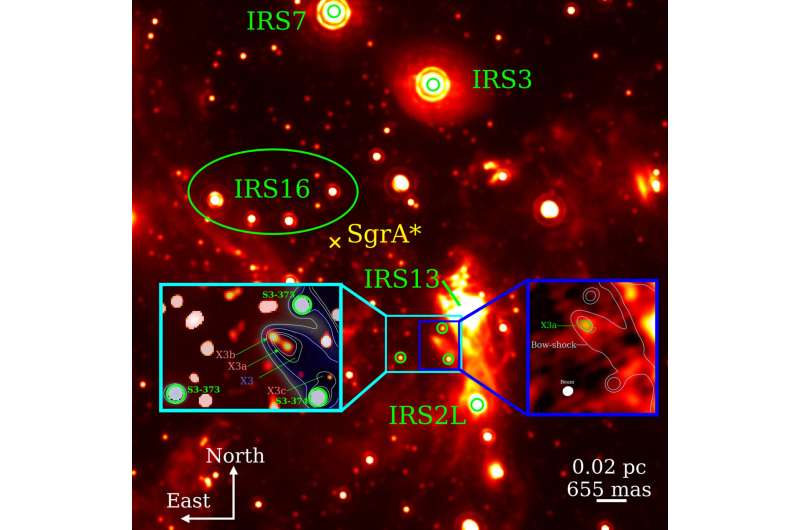
An international team of researchers under the leadership of Dr. Florian Peißker at the University of Cologne's Institute of Astrophysics has discovered a very young star in its formation phase near the supermassive black hole Sagittarius A* (Sgr A*) at the center of our Milky Way.
The star is only several tens of thousands of years old, making it younger than humanity. The special thing about baby star X3a is that theoretically it should not be able to exist so close to the supermassive black hole in the first place.
However, the team believes that it formed in a dust cloud orbiting the giant black hole and sank to its current orbit only after it had formed. The study "X3: a high-mass Young Stellar Object close to the supermassive black hole Sgr A*" has been published in The Astrophysical Journal.
The vicinity of the black hole at the center of our galaxy is generally considered to be a region characterized by highly dynamic processes and hard X-ray and UV radiation. Precisely these conditions act against the formation of stars like our sun. Therefore, for a long time scientists had assumed that over periods of billions of years, only old, evolved stars can settle by dynamical friction in the vicinity of the supermassive black hole.
However, quite surprisingly, already twenty years ago very young stars were found in the immediate vicinity of Sgr A*. It is still not clear how these stars got there or where they formed. The occurrence of very young stars very close to the supermassive black hole has been referred to as "the paradox of youth."
The baby star X3a—which is ten times as big and fifteen times as heavy as our sun—could now close the gap between star formation and the young stars in the immediate vicinity of Sgr A*. X3a needs special conditions to form in the immediate vicinity of the black hole.
First author Dr. Florian Peißker explained, "It turns out that there is a region at a distance of a few light years from the black hole which fulfills the conditions for star formation. This region, a ring of gas and dust, is sufficiently cold and shielded against destructive radiation."
Low temperatures and high densities create an environment in which clouds of hundreds of solar masses can form. These clouds can in principle move very fast towards the direction of the black hole due to cloud–cloud collisions and scattering that remove the angular momentum.
In addition, very hot clumps formed in close proximity to the baby star which could then be accreted by X3a. These clumps could thus also contribute to X3a reaching such a high mass in the first place. However, these clumps are only a part of the formation history of X3a. They still do not explain its "birth."
The scientists assume the following scenario to be possible: shielded from the gravitational influence of Sgr A* and intense radiation, a dense enough cloud could have formed in the outer gas and dust ring around the center of the Galaxy. This cloud had a mass of about one hundred suns and collapsed under its own gravity to one or more protostars.
"This so-called fall time approximately corresponds to the age of X3a," Peißker added. Observations have shown that there are many of these clouds that can interact with each other. It is therefore likely that a cloud falls towards the black hole from time to time.
This scenario would also fit X3a's stellar development phase, which is currently evolving into a mature star. It is therefore quite plausible that the gas and dust ring acts as the birthplace of the young stars in the center of our Galaxy.
Dr. Michal Zajaček at Masaryk University in Brno (Czech Republic), a co-author of the study, clarified, "With its high mass of about ten times the solar mass, X3a is a giant among stars, and these giants evolve very quickly towards maturity. We have been lucky to spot the massive star in the midst of the comet-shaped circumstellar envelope. Subsequently, we identified key features associated with a young age, such as the compact circumstellar envelope rotating around it."
Since similar dust and gas rings can be found in other galaxies, the described mechanism could apply there as well. Many galaxies can therefore host very young stars in their very centers. Planned observations with NASA's James Webb Space Telescope or the European Southern Observatory's Extremely Large Telescope in Chile will test this star formation model for our Galaxy as well as others.
More information: Florian Peißker et al, X3: A High-mass Young Stellar Object Close to the Supermassive Black Hole Sgr A*, The Astrophysical Journal (2023). DOI: 10.3847/1538-4357/aca977
Provided by University of Cologne
Citation: Baby star near the black hole in the middle of our Milky Way: It exists after all (2023, February 28) retrieved 1 March 2023 from https://ift.tt/YkSRIfe
This document is subject to copyright. Apart from any fair dealing for the purpose of private study or research, no part may be reproduced without the written permission. The content is provided for information purposes only.
Science - Latest - Google News
February 28, 2023 at 10:28PM
https://ift.tt/prKXD3m
Baby star near the black hole in the middle of our Milky Way: It exists after all - Phys.org
Science - Latest - Google News
https://ift.tt/qaZ1o8E
https://ift.tt/bhTx7HV
Bagikan Berita Ini

















0 Response to "Baby star near the black hole in the middle of our Milky Way: It exists after all - Phys.org"
Post a Comment